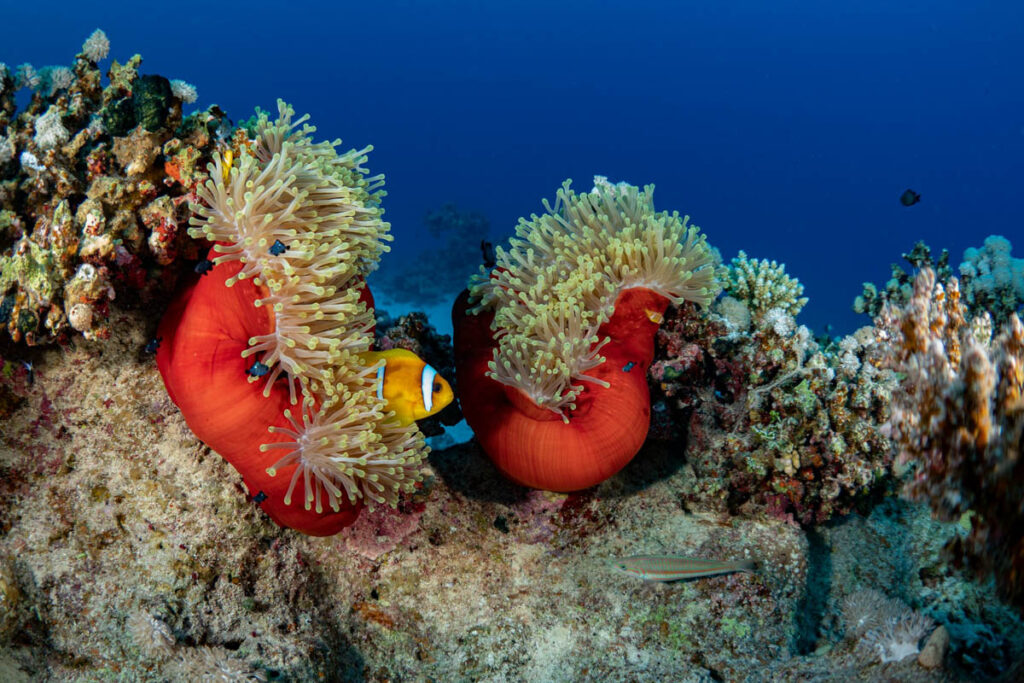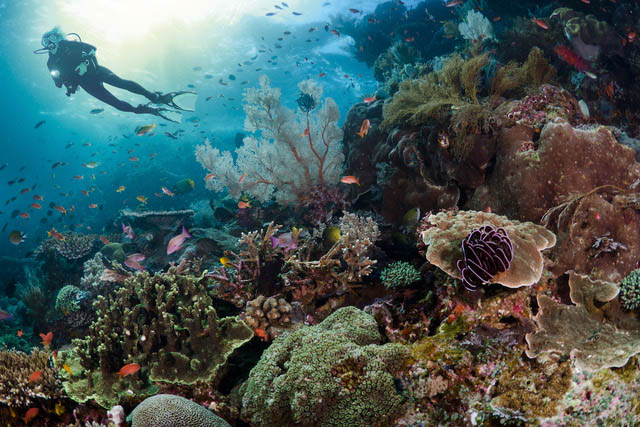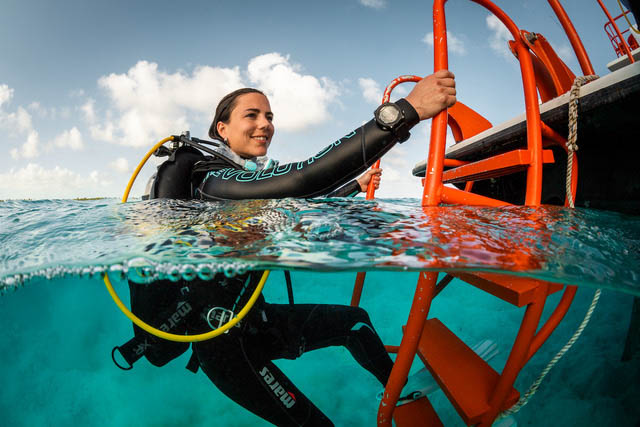Scuba diving is an amazing sport that allows you to explore the underwater world and encounter marine life in idyllic destinations worldwide. It is easy to learn, you can do a diving course almost anywhere in the world, and it’s a great way to make new friends.
Whether you’re considering trying scuba diving on vacation or learning at home, starting with the right foundation is crucial. In this guide, we’ll cover the essential tips and tricks for beginners, along with some advanced advice to help you build confidence and safety as you progress in your diving journey.
Why Scuba Diving is Worth Exploring
Scuba diving allows you to see the world in an entirely new way and explore underwater ecosystems you never knew existed. From vibrant coral reefs and shipwrecks to marine species large and small, diving allows you to engage with nature in a way that few other activities can match.
When you learn to scuba dive, you master new skills that build your self-confidence and trust. It is a great sport to do with your family and friends or try on vacation and the scuba diving community is very welcoming and inclusive.
For beginners, the challenge lies in mastering the necessary skills and knowledge to ensure each dive is safe and enjoyable. By focusing on the fundamentals and gradually learning more advanced techniques, you can become a competent and confident diver.

Photo by Pascal van de Vendel on Unsplash
Getting Started: What You Need to Know
1. Choose the Right Certification Course
The first step in your scuba diving journey is obtaining your scuba diving certification. Several organizations offer courses that cover the basics of diving, including safety protocols, equipment use, and underwater communication.
When choosing a certification course, consider the following:
- Reputation of the Dive School: Look for a dive center with experienced instructors and positive reviews.
- Class Size: Smaller class sizes often provide more personalized instruction.
- Location: Choose a course that allows you to complete your theory sessions online and do your open-water dives in conditions similar to where you plan to dive in the future.

Photo by Ryan Geller on Unsplash
If you want to learn to dive somewhere with plenty of sunshine, warm, calm waters and beautiful marine life, check out these beginner-friendly dive destinations:
If you’re planning to dive in challenging conditions, such as cold water or strong currents, consider taking a specialized course after your initial certification. Courses like SSI’s Advanced Adventurer can equip you with skills for deeper dives, night diving, and navigating in low visibility.
2. Understand the Equipment
Scuba diving equipment can seem complicated at first, but understanding the basics is essential for your safety and enjoyment. The main pieces of equipment you’ll use include:
- Mask: Allows you to see underwater.
- Snorkel: Helps you breathe on the surface without using air from your tank.
- Fins: Help you to move efficiently through the water.
- Buoyancy Control Device (BCD): A vest that helps you control your buoyancy.
- Regulator: The device that delivers air from your tank to your mouth.
- Dive Computer: Tracks your depth and time underwater to ensure safe diving limits.
Make sure you are comfortable with your gear before diving. Practice using it in a controlled environment like a pool, and don’t hesitate to ask your diving instructor questions about how it works.
3. Learn About Buoyancy Control
Buoyancy control is one of the most important skills you’ll learn as a diver. Proper buoyancy allows you to move effortlessly through the water, conserve energy, and avoid damaging delicate marine ecosystems. Here are a few tips to help you master buoyancy:
- Practice in Shallow Water: Get comfortable with adjusting your buoyancy by practicing in shallow water before moving to deeper dives.
- Use Your Breath: Your lungs play a significant role in controlling your buoyancy. Taking slow, deep breaths will help you rise, while exhaling will help you sink slightly.
- Be Patient: Buoyancy control takes time to master, so don’t rush the learning process. Each dive will help you improve.
As you learn more about scuba diving, experiment with different types of weights, such as soft weights or integrated weight systems to fine-tune your buoyancy. Additionally, consider joining a Perfect Buoyancy course to hone your buoyancy skills.
4. Learn to Communicate Underwater
Since you can’t talk underwater, divers use hand signals to communicate. Learning these signals is essential for coordinating with your dive buddy and ensuring a safe dive. Standard hand signals are used to convey messages like “OK,” “Ascend,” and “Problem.” Here are some key points:
- Learn the Signals: Familiarize yourself with the most common hand signals before your first dive. You will learn these during your Open Water Diver course.
- Practice with Your Buddy: Ensure that both you and your dive buddy are using the same signals to avoid confusion.
- Signal Early: If you encounter a problem or have a question, signal your buddy as soon as possible to prevent misunderstandings.
As you gain experience, practice communicating without relying solely on hand signals. This can include using dive lights to signal in low visibility or practicing non-verbal cues like eye contact and body language to communicate intent.
5. Equalize Your Ears Early and Often
As you descend, the pressure on your ears increases, which can be uncomfortable or even painful. To prevent this, you need to equalize the pressure in your ears. Here’s how:
- Pinch Your Nose and Gently Blow: This is known as the Valsalva maneuver and is the most common method of equalizing.
- Swallow or Wiggle Your Jaw: These actions can also help equalize the pressure.
- Start Early: Begin equalizing as soon as you start your descent and continue doing so regularly.
If you feel pain in your ears, ascend slightly and try equalizing again. Never try to push past the pain. If you have trouble equalizing, ask your instructor about the Frenzel maneuver. This involves using your tongue to push air into the Eustachian tubes without exerting pressure on your lungs. This technique is particularly useful for deep dives or when dealing with persistent equalization issues.
6. Always Dive with a Buddy
Diving with a buddy is a standard safety practice in scuba diving that enhances your ability to handle emergencies and enjoy the dive. Here’s how to make the most of the buddy system:
- Pre-Dive Checks: Always perform a pre-dive check with your buddy to ensure that all equipment is functioning correctly.
- Stay Close: Keep within arm’s reach of your buddy at all times.
- Communicate: Regularly check in with your buddy during the dive using hand signals.
As you dive more, focus on developing a “team diving” mindset, where you and your buddy work together to manage dive planning, navigation, and dive objectives. This approach is especially valuable when exploring complex dive environments like wrecks and caves.
7. Respect Marine Life and the Environment
One of the greatest joys of scuba diving is encountering marine life in its natural habitat. However, it’s important to remember that we are visitors in their world. Here are some ways to make sure you are a responsible diver:
- Don’t Touch: Avoid touching marine life or coral, as this can harm them.
- Don’t Feed the Fish: Feeding fish can disrupt their natural behavior and diet.
- Be Mindful of Your Fins: Kicking up sand or debris can damage the environment and reduce visibility.
- Choose Eco-Friendly Products: Always choose reef-safe sunscreen and avoid using disposable plastics.
Once you become a certified diver, connect with other divers by joining an online diving community, and get involved in marine conservation by participating in reef cleanups or citizen science projects. Contributing to conservation efforts not only helps protect the marine environment but also deepens your connection to the underwater world.
Just remember that scuba diving is a skill that takes time to develop, so be patient with yourself as you learn and don’t rush. Everyone learns at their own pace and it’s perfectly normal to have pre-dive fears. Focus on each dive as an opportunity to improve your technique, explore new environments, have fun, and gain confidence.








